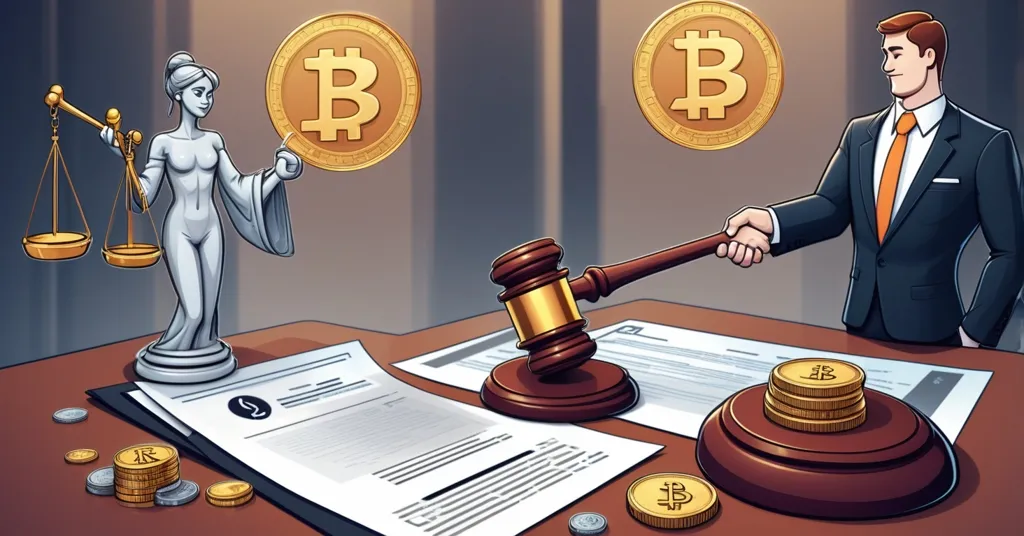SEC and Ripple Labs Settle XRP Dispute: A Regulatory Milestone for Crypto

SEC and Ripple Labs Reach Settlement: A Turning Point for XRP and Crypto Regulation
In a groundbreaking move that could reshape the future of digital assets, the SEC and Ripple Labs have proposed a settlement over the classification of XRP. If approved by Judge Analisa Torres, this agreement could mark the end of a legal battle that has captivated the crypto world since December 2020.
- SEC files settlement with Ripple Labs over XRP.
- Ripple to pay $50 million, receive $75 million back from escrow.
- Settlement could set precedent for digital asset regulation.
The SEC’s filing seeks approval for a settlement where Ripple Labs, along with its executives Christian A. Larsen and Bradley Garlinghouse, will pay a $50 million penalty. In a twist that offers Ripple some financial relief, $75 million from a $125 million escrow account will be returned to the company. This settlement aims to dissolve a court order that previously halted certain actions by Ripple, paving the way for a potential resolution to the SEC’s civil enforcement action.
But what exactly is XRP, you ask? It’s a digital asset developed by Ripple Labs, designed to streamline cross-border payments. The SEC’s lawsuit against Ripple, launched in December 2020, accused the company of conducting unregistered securities offerings with XRP. This sparked a heated debate over whether digital assets should be classified as securities.
If Judge Analisa Torres gives the green light to this agreement, the case will head back to the district court for finalization, potentially closing a saga that’s been closely watched by the crypto community. The court’s ruling in August 2024 found that Ripple’s institutional sales of XRP violated Section 5 of the Securities Act of 1933, but not secondary sales, adding a layer of complexity to the case.
This settlement isn’t just about Ripple and XRP; it’s a potential game-changer for the entire crypto industry. It could set a precedent for how the SEC handles similar cases in the future. With the regulatory environment evolving, the SEC’s Crypto Task Force is working on a new “regulatory path” that might influence future frameworks. However, not everyone’s on board. SEC Commissioner Crenshaw dissented, arguing that the settlement undermines the court’s order and the SEC’s enforcement program, raising concerns about investor protection.
Ripple hasn’t just been sitting back, either. They’ve been strategically engaging with policymakers, including some high-profile lobbying efforts, to shape the narrative around XRP. This settlement could signal a broader shift in how fintech and digital asset firms approach the U.S. market, potentially encouraging more companies to expand and coexist within regulated financial infrastructure.
Yet, it’s not all sunshine and rainbows. The dissent from Commissioner Crenshaw highlights the tension between regulatory oversight and the desire to foster innovation in the crypto space. While the settlement may offer relief for Ripple and its investors, it underscores the ongoing debate over how to protect investors while allowing digital assets to flourish.
On the flip side, Ripple executives and industry experts are optimistic. “This settlement represents a step forward in clarifying the regulatory landscape for digital assets,” a Ripple spokesperson stated. This clarity could encourage further innovation and adoption of cryptocurrencies, a bright spot in an otherwise murky regulatory landscape.
As we navigate this turning point, it’s crucial to remain both optimistic and vigilant. The crypto landscape is filled with both promise and pitfalls, and understanding the nuances of cases like Ripple’s is essential for anyone invested in the future of decentralized finance.
Key Takeaways and Questions
-
What is the proposed settlement between the SEC and Ripple Labs?
The proposed settlement involves Ripple paying a $50 million penalty to the SEC, with $75 million being returned to Ripple from a $125 million escrow account.
-
Who are the defendants in the SEC’s civil enforcement action against Ripple?
The defendants are Ripple Labs, Inc., Christian A. Larsen, and Bradley Garlinghouse.
-
What would happen if Judge Analisa Torres approves the settlement?
If approved, the case would be sent back to the district court to finalize the settlement, likely ending the appeals and resolving the legal dispute.
-
What implications could the settlement have for the regulation of digital assets in the U.S.?
The settlement could set a precedent for how digital assets are regulated, potentially influencing future SEC actions and regulatory frameworks.
-
What is the significance of the escrow account in the settlement agreement?
The escrow account holds $125 million, from which $50 million would be paid as a penalty to the SEC, and the remaining $75 million would be returned to Ripple.
-
How has Ripple engaged with policymakers?
Ripple has engaged in lobbying efforts to shape the narrative around XRP and influence regulatory discussions.
-
What are the potential challenges and criticisms of the settlement?
The main criticism comes from SEC Commissioner Crenshaw, who argues that the settlement undermines investor protection and the SEC’s enforcement program.



